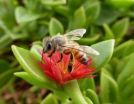(Press-News.org) NEW YORK (17 April 2014)— Population Council scientists and their partners have found that their proprietary microbicide gel is safe, stable, and can prevent the transmission of multiple sexually transmitted infections (STIs) in both the vagina and rectum in animals: HIV, herpes simplex virus 2 (HSV-2), and human papillomavirus (HPV). The USAID-funded study also provides the first data that the gel is effective against multiple strains of HIV, and has a window of efficacy in the vagina against all three viruses of at least eight hours prior to exposure. A Phase 1 safety trial of the gel is set to begin enrollment in May 2014.
These findings were published today in PLOS ONE in an article entitled "A Potent Combination Microbicide that Targets SHIV-RT, HSV-2 and HPV."
The gel, known as MZC, contains two potent antiviral agents: MIV-150 and zinc acetate. MIV-150 is an enzyme inhibitor that prevents HIV-infected cells from producing new virus, and zinc acetate is an antiviral agent with known activity against HIV and HSV-2. These compounds are mixed in a base of carrageenan, a compound derived from seaweed that has also been shown to have potent activity against HPV. Infection with HSV-2 or HPV is associated with increased risk of HIV infection. Microbicides that target HIV, HSV-2, and HPV may more effectively limit HIV transmission than those that target HIV alone.
In this study, Council scientists and their partners used macaque and mouse models to examine whether MZC gel could prevent the vaginal and rectal transmission of SHIV-RT, HSV-2, and HPV. SHIV-RT is a human/simian immunodeficiency chimeric virus combining the HIV reverse transcriptase (RT) within SIV (the monkey version of HIV). MIV-150 and zinc acetate inhibit HIV-RT via different mechanisms of action. Preclinical testing in animals is required by the FDA and is important to ensure the highest level of safety and to build the evidence base for potential efficacy in humans.
"It is the versatility of MZC that makes it a desirable microbicide candidate," said José A. Fernández Romero, a scientist at the Population Council and corresponding author of the paper. "It is effective against multiple viruses, can be used in both the vagina and the rectum, and retains its efficacy in the vagina over an extended period of time. In addition to the gel, we are also exploring sustained-release intravaginal rings and on-demand film-based delivery systems for MZC. There is a growing demand for microbicides that prevent multiple STIs, and we are committed to ensuring that women and men have options when choosing what works most effectively for their own protection."
INFORMATION:
This research was made possible by the generous support of the American people through the US Agency for International Development (USAID), GPO-A-00-04-00019-00. The contents are the responsibility of the authors and do not necessarily reflect the views of USAID or the United States Government.
Article citation: Kizima L, Rodríguez A, Kenney J, Derby N, Mizenina O, et al. (2014) A Potent Combination Microbicide that Targets SHIV-RT, HSV-2 and HPV. PLoS ONE 9(4): e94547. doi:10.1371/journal.pone.0094547
About the Population Council
The Population Council confronts critical health and development issues—from stopping the spread of HIV to improving reproductive health and ensuring that young people lead full and productive lives. Through biomedical, social science, and public health research in 50 countries, we work with our partners to deliver solutions that lead to more effective policies, programs, and technologies that improve lives around the world. Established in 1952 and headquartered in New York, the Council is a nongovernmental, nonprofit organization governed by an international board of trustees.
Media contact
Melanie Boyer: mboyer@popcouncil.org; +1 202 237 9404
Animal study provides first evidence that gel can prevent multiple virus transmission in vagina/rectum
2014-04-17
ELSE PRESS RELEASES FROM THIS DATE:
Wireless power transfer achieved at 5-meter distance
2014-04-17
Daejeon, Republic of Korea, April 17, 2014 – The way electronic devices receive their power has changed tremendously over the past few decades, from wired to non-wired. Users today enjoy all kinds of wireless electronic gadgets including cell phones, mobile displays, tablet PCs, and even batteries. The Internet has also shifted from wired to wireless. Now, researchers and engineers are trying to remove the last remaining wires altogether by developing wireless power transfer technology.
Chun T. Rim, a professor of Nuclear & Quantum Engineering at KAIST, and his team ...
Fear of the cuckoo mafia
2014-04-17
This news release is available in German. If a restaurant owner fails to pay the protection money demanded of him, he can expect his premises to be trashed. Warnings like these are seldom required, however, as fear of the consequences is enough to make restaurant owners pay up. Similarly, mafia-like behaviour is observed in parasitic birds, which lay their eggs in other birds' nests. If the host birds throw the cuckoo's egg out, the brood parasites take their revenge by destroying the entire nest. Consequently, it is beneficial for hosts to be capable of learning and ...
East African honeybees are safe from invasive pests… for now
2014-04-17
Several parasites and pathogens that devastate honeybees in Europe, Asia and the United States are spreading across East Africa, but do not appear to be impacting native honeybee populations at this time, according to an international team of researchers.
The invasive pests include including Nosema microsporidia and Varroa mites.
"Our East African honeybees appear to be resilient to these invasive pests, which suggests to us that the chemicals used to control pests in Europe, Asia and the United States currently are not necessary in East Africa," said Elliud Muli, senior ...
Drought and fire in the Amazon lead to sharp increases in forest tree mortality
2014-04-17
Ongoing deforestation and fragmentation of forests in the Amazon help create tinderbox conditions for wildfires in remnant forests, contributing to rapid and widespread forest loss during drought years, according to a team of researchers.
The findings show that forests in the Amazon could reach a "tipping point" when severe droughts coupled with forest fires lead to large-scale loss of trees, making recovery more difficult, said Jennifer Balch, assistant professor of geography, Penn State.
"We documented one of the highest tree mortality rates witnessed in Amazon forests," ...
Classifying cognitive styles across disciplines
2014-04-17
Educators have tried to boost learning by focusing on differences in learning styles. Management consultants tout the impact that different decision-making styles have on productivity. Various fields have developed diverse approaches to understanding the way people process information. A new report from psychological scientists aims to integrate these disciplines by offering a new, integrated framework of cognitive styles that bridges different terminologies, concepts, and approaches.
"This new taxonomy of cognitive styles offers a clear categorization of different types ...
Unraveling the 'black ribbon' around lung cancer
2014-04-17
It's not uncommon these days to find a colored ribbon representing a disease. A pink ribbon is well known to signify breast cancer. But what color ribbon does one think of with lung cancer?
Although white has been identified as the designated color, for many suffering from the disease, black may be the only one they think fits.
A Michigan State University study consisting of lung cancer patients, primarily smokers between the ages of 51 to 79 years old, is shedding more light on the stigma often felt by these patients, the emotional toll it can have and how health providers ...
Some immune cells defend only 1 organ
2014-04-17
Scientists have uncovered a new way the immune system may fight cancers and viral infections. The finding could aid efforts to use immune cells to treat illness.
The research, in mice, suggests that some organs have the immunological equivalent of "neighborhood police" – specialized squads of defenders that patrol only one area, a single organ, instead of an entire city, the body.
Scientists at Washington University School of Medicine in St. Louis have shown that the liver, skin and uterus each has dedicated immune cells, which they call tissue-resident natural killer ...
Deaths from viral hepatitis surpasses HIV/AIDS as preventable cause of deaths in Australia
2014-04-17
The analysis was conducted by Dr Benjamin Cowie and Ms Jennifer MacLachlan from the University of Melbourne and Melbourne Health, and was presented at The International Liver Congress in London earlier this month.
"Liver cancer is the fastest increasing cause of cancer deaths in Australia, increasing each year by 5 per cent, so by more than seventy people each year. In 2014 there was an estimated number of deaths of around 1,500 from liver cancer. The predominant cause is chronic viral Hepatitis," Dr Cowie said.
Hepatitis refers to the inflammation of the liver. Chronic ...
Ancient sea-levels give new clues on ice ages
2014-04-17
International researchers, led by the Australian National University (ANU), have developed a new way to determine sea-level changes and deep-sea temperature variability over the past 5.3 million years.
The findings will help scientists better understand the climate surrounding ice ages over the past two million years, and could help determine the relationship between carbon dioxide levels, global temperatures and sea levels.
The team from ANU, the University of Southampton (UoS) and the National Oceanography Centre (NOC) in the United Kingdom, examined oxygen isotope ...
Scientists find new way to fight malaria drug resistance
2014-04-17
An anti-malarial treatment that lost its status as the leading weapon against the deadly disease could be given a new lease of life, with new research indicating it simply needs to be administered differently.
The findings could revive the use of the cheap anti-malarial drug chloroquine in treating and preventing the mosquito-bourne disease, which claims the lives of more than half a million people each year around the world.
The parasite that causes malaria has developed resistance to chloroquine, but research carried out at the Australian National University (ANU) ...




